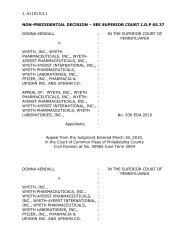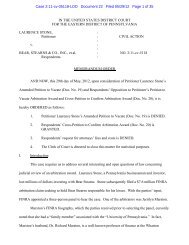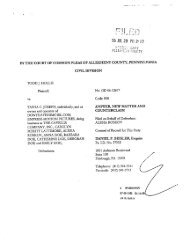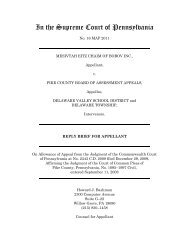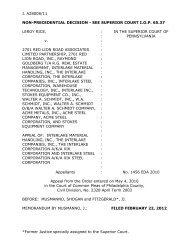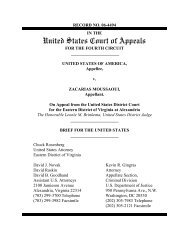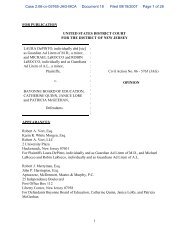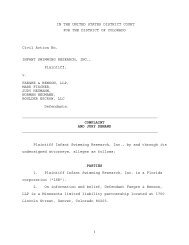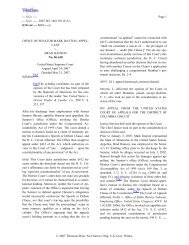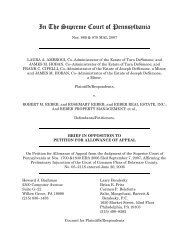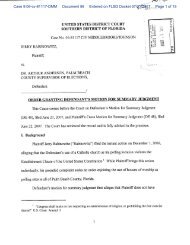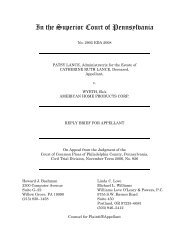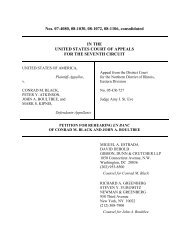In the Superior Court of Pennsylvania - How Appealing
In the Superior Court of Pennsylvania - How Appealing
In the Superior Court of Pennsylvania - How Appealing
You also want an ePaper? Increase the reach of your titles
YUMPU automatically turns print PDFs into web optimized ePapers that Google loves.
<strong>In</strong> <strong>the</strong>se 14 consolidated appeals, <strong>the</strong> <strong>Superior</strong> <strong>Court</strong> — in accordance with its<br />
earlier unanimous ruling in Simon — held that plaintiffs’ invocation <strong>of</strong> <strong>the</strong><br />
discovery rule to make <strong>the</strong>ir suits timely could not be resolved in favor <strong>of</strong> <strong>the</strong><br />
defendants as a matter <strong>of</strong> law on summary judgment. Ra<strong>the</strong>r, <strong>the</strong> <strong>Superior</strong> <strong>Court</strong><br />
ruled that numerous genuine issues <strong>of</strong> material fact existed — concerning both<br />
plaintiffs’ invocation <strong>of</strong> <strong>the</strong> discovery rule in general and <strong>the</strong> question <strong>of</strong> plaintiffs’<br />
reasonable diligence to discover whe<strong>the</strong>r <strong>the</strong>ir breast cancers had been caused by<br />
<strong>the</strong> tortious conduct <strong>of</strong> a third–party — necessitating that juries resolve <strong>the</strong><br />
discovery rule’s applicability in each <strong>of</strong> <strong>the</strong>se 14 cases.<br />
<strong>In</strong> violation <strong>of</strong> <strong>Pennsylvania</strong> Rule <strong>of</strong> Appellate Procedure 1115(d), which<br />
requires <strong>the</strong> petitioner to present with “accuracy * * * whatever is essential to a<br />
ready and adequate understanding <strong>of</strong> <strong>the</strong> points requiring consideration,” Wyeth<br />
and Upjohn’s Petition for Allowance <strong>of</strong> Appeal incorrectly contends that <strong>the</strong><br />
<strong>Superior</strong> <strong>Court</strong> has ruled that <strong>the</strong> discovery rule will toll <strong>the</strong> running <strong>of</strong> <strong>the</strong> statute<br />
<strong>of</strong> limitations in a prescription drug failure to warn lawsuit until a “definitive<br />
causal link” or “conclusive connection” is established between <strong>the</strong> medication and<br />
<strong>the</strong> plaintiff’s injury. Had <strong>the</strong> <strong>Superior</strong> <strong>Court</strong> in fact so ruled, <strong>the</strong> <strong>Superior</strong> <strong>Court</strong><br />
trial court had originally failed to address in violation <strong>of</strong> Pa. R. Civ. P. 227.1(e),<br />
instead <strong>of</strong> pursuing allowance <strong>of</strong> appeal in this <strong>Court</strong> from <strong>the</strong> <strong>Superior</strong> <strong>Court</strong>’s<br />
reversal <strong>of</strong> <strong>the</strong> trial court’s entry <strong>of</strong> j.n.o.v. in Upjohn’s favor. Upjohn’s failure to<br />
seek allowance <strong>of</strong> appeal from <strong>the</strong> <strong>Superior</strong> <strong>Court</strong>’s statute <strong>of</strong> limitations ruling in<br />
Simon indicates that Upjohn realized that <strong>the</strong> discovery rule issue presented in<br />
Simon (and, by extension, in <strong>the</strong>se 14 consolidated cases) does not satisfy <strong>the</strong><br />
stringent criteria for review on allowance <strong>of</strong> appeal.<br />
– 21 –



